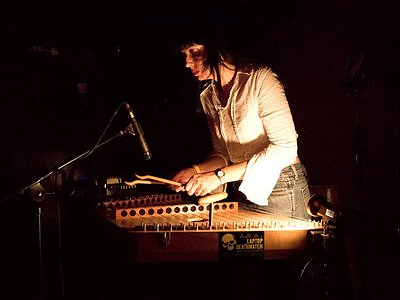Name: Sarah Ruth
Occupation: Composer, improviser, sound artist
Nationality: American
Recent release: Sarah Ruth teams up with Monte Espina for Cuatro Estaciones, out now via Full Spectrum.
If you enjoyed these thoughts by Sarah Ruth and would like to find out more about her work, visit her official website. She is also on Instagram, and bandcamp.
Can you talk a bit about your interest in or fascination for sound? What were early experiences which sparked it?
I remember my great uncle coming to visit us on the family farm. We would be outside, walking around listening to the birds and he would mimic the bird calls and the birds would respond! I thought that was such a neat trick! That is my first memory of a ‘call and response’ interaction with nature.
There were a few times during the recording of Cuatro Estaciones that it seemed we had entered into a ‘call and response’ interaction with the birds, insects, and wild life. We were listening and responding and I like to think maybe they were too.
Which artists, approaches, albums or performances using sound in an unusual or remarkable way captured your imagination in the beginning?
So many. But at some point at the beginning of the pandemic, I got really into the works of Raven Chacon, particularly the album An Anthology of Chants Operations. My favorite track off that album is “Study for Human-made Bird Calls and Microphone out a Moving Car Window” which the title alone already had me, I felt sure I was going to like it a lot.
The album weaves together field recordings, site specific sound installations, environmental and self-generated sounds in a deeply meaningful way, a sort of sonic activism.
What's your take on how your upbringing and cultural surrounding have influenced your sonic preferences?
I grew up in the Texas Panhandle area, which is known for its strong winds. Growing up in old farm houses, the wind whistling through was often my lullaby. It’s a rather spooky sound and I could sometimes hear other things going on, voices even. Voices being blown in from other places provoking wonder at who could be out there and why? Voices maybe being blown into the present from the past even.
I still hear this on especially windy days. But am also aware of my feral imagination which stems from being an only child out in the middle of nowhere left to my own devices for entertainment.
Working predominantly with field recordings and sound can be an incisive step / transition. Aside from musical considerations, there can also be personal motivations for looking for alternatives. Was this the case for you, and if so, in which way?
I think of Cuatro Estaciones as a sonic representation of what each season sounded like in that exact moment and how we all responded to it in the moment, frozen in time like a photo. So for me it’s a historical artifact due to the fact that at some point the aquatic plant farm will be something else entirely as developers / urban sprawl encroaches. I see this happening more and more.
There will be little bits of farmland surrounded by urban development until finally someone dies off and the children relent to selling. You can see evidence of that scenario play out all over and it’s sad.
The idea of acoustic ecology has drawn a lot of attention to the question of how much we are affected by the sound surrounding us. What's your take on this and on acoustic ecology as a movement in general?
I think it is important to acknowledge the world around us and amplify the aspects that are not human made with the hopes that such an action would open people up to how important it is to be in nature and preserve it.
Near where I live now, which is on the edge of the city limits, there’s a last remnant of farm land, less than a mile from my house that’s about to be re-zoned for single family homes and apartments. Ten years ago where there are now a bunch of chain stores there used to be longhorn cattle roaming, that was also within the city limits. Urban sprawl is killing off our open spaces and it’s scary.
I see all these new apartment complexes and sub-divisions of housing and they just look cheap. They are not being built to last.




